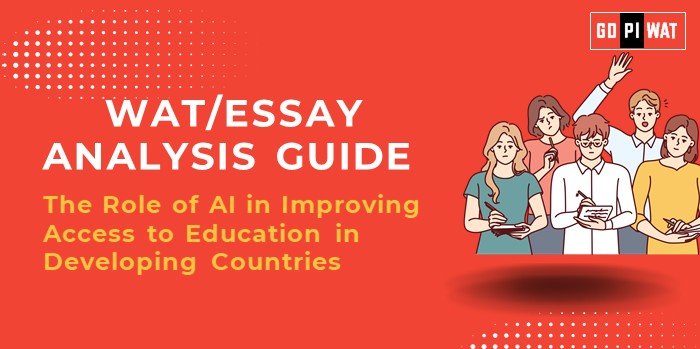📋 WAT/Essay Analysis Guide: The Role of AI in Improving Access to Education in Developing Countries
🌐 Understanding the Topic’s Importance
AI reshapes education, addressing access and equity challenges in developing nations. It aligns with economic development goals, ensuring inclusivity in education.
📝 Effective Planning and Writing
- ⏱️ Time Allocation:
- Planning: 5 minutes
- Writing: 20 minutes
- Reviewing: 5 minutes
📖 Introduction Techniques for Essays
🎭 Contrast Approach:
“While over 50% of children in developing countries lack access to primary education, AI tools like Duolingo are revolutionizing learning in underserved regions.”
🔧 Solution-Based Approach:
“AI emerges as a catalyst for equitable education, offering low-cost, scalable solutions for developing nations.”
📚 Structuring the Essay Body
🏆 Achievements:
- Highlight progress in adaptive learning tools and cost reduction.
⚠️ Challenges with Comparative Analysis:
- Discuss digital divides and infrastructural gaps, referencing global examples like Estonia’s success and Sub-Saharan Africa’s challenges.
🔮 Future Outlook:
- Envision AI-integrated rural schools, public-private partnerships, and policy reforms.
📌 Concluding Effectively
⚖️ Balanced Approach:
“AI’s integration in education offers immense promise, but achieving equitable access demands addressing infrastructural and ethical challenges.”
🌍 Future-Focused:
“With strategic investments, AI can transform education in developing nations, driving progress toward global education goals.”
📄 Sample Short Essays
⚖️ Balanced Perspective:
“AI, as a tool for education, offers immense opportunities but faces implementation hurdles like infrastructure and cultural acceptance.”
🔧 Solution-Oriented:
“By localizing content and leveraging low-cost solutions, AI can revolutionize education in developing nations.”
🌍 Global Comparison:
“Countries like Estonia highlight AI’s potential, which developing nations must harness through targeted initiatives.”


